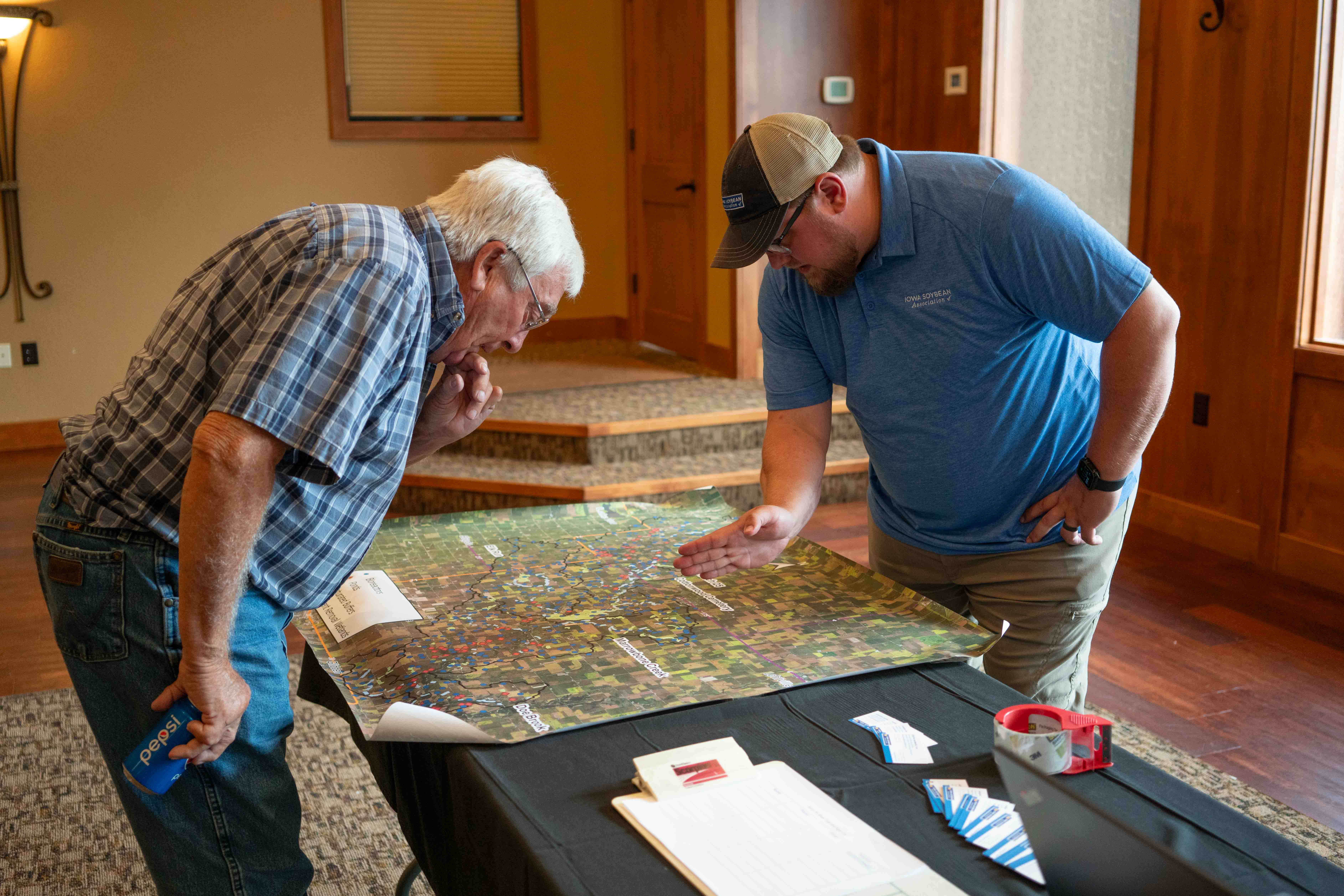
ISA Conservation Agronomist Joe Wuebker (right) outlines edge-of-field practices on a watershed map (Photo credit: Iowa Soybean Association/Joseph Hopper)
Strengthening the partnership
August 3, 2023
RCFI focuses on new opportunities, continued success in Farm to River Partnership
The North Raccoon Farm to River Partnership project, which encompasses Carroll, Calhoun, Sac and Greene Counties, is a more than $4 million Water Quality Initiative (WQI) which began in 2018 to increase conservation practices on the land for improved water quality in the North Raccoon River watershed. Nearing the final year of its current grant in 2024, Iowa Soybean Association’s (ISA) Research Center for Farming Innovation (RCFI) staff met with local farmers Wednesday in Carroll to discuss how far the project has come, the positive changes which have come because of the adopted conservation practices, as well as the opportunities to do even more in the area going forward.
The genesis of the Farm to River Partnership began in 2015 as a three-year WQI demonstration project in the Elk Run watershed, then known as the Elk Run WQI. In 2018, the Farm to River Partnership expanded into a larger sub-watershed and became the current North Raccoon Farm to River Partnership as it is known today.
“As you drive over to Highway 71 north, Elk Run sits right there,” says Roger Wolf, ISA director of conservation and Agriculture’s Clean Water Alliance (ACWA) executive director. “Well if you look at the nitrogen concentration over many years, we knew that Elk Run was elevated compared to some of the other sub-watersheds. ACWA organized a meeting in this room, we set it up and said, ‘here’s the data, here’s what we 've been learning over the years and we’d like to be proactive. We have an opportunity with IDALS to write a grant and help farmers implement some of the practices that would reduce nutrient loss.’
He adds, “Nutrient management, reduced tillage, cover crops, extended rotations, edge-of-field practices, wetlands, those are the practices, right? We had a handful of farmers here and they said, ‘that sounds like a pretty decent idea, why don't we learn about this?’ That became the Elk Run WQI.”
Better, faster, together
ISA Conservation Agronomist Joe Wuebker oversees the ACWA-administered project and was on hand Wednesday to explain alongside Wolf how there are still opportunities to do more. One opportunity discussed by Wuebker and RCFI staff included the Regional Conservation Partnership Program (RCPP) which is a five-year federally funded water quality project in the larger North Raccoon Watershed, which the Farm to River Partnership is included. A new innovation Wuebker discussed was the success of Polk County’s “batch and build” methods to scale up and simplify conservation adoption on the ground.
“We're looking for increasing efficiency, speed and cost trying to do this better than ever before so we can continue to do this as we move further into this project and other projects,” Wuebker says.
“We were fortunate to have Joe (Wuebker) come on and we created this position called conservation agronomist, which was trying to leverage more of the ag retail,” says Wolf. “We theorized ag retail has a stake in the success of this too. The common denominator is: we want to get more conservation on the ground just like the agencies do. How can we help bring in more farmers? Just because we're there doesn't mean every farmer’s going to sign up. What are all the hurdles, all that stuff?
He continued, “This whole batch and build is about how do we make it easier, faster, how do we make this happen? We're reaching kind of the twilight year in the current WQI, we're asking the question: how are we going to get these edge-of-field practices implemented? There's a very robust story here. There has been some success, the job isn't done yet. That’s my message. There are opportunities, lots of people who would like to help. We've got to regroup, strengthen some partnerships, work with the soil districts, county supervisors, they all have a significant role to implement this.”
Don Meyer, a local farmer, said it was a cold call from ISA answering his questions about the project and edge-of-field practices which ultimately led to his decision to install a bioreactor on his farm. He credited ISA’s in-person approach and the simple methods to construct a bioreactor: “dig the whole thing up, put in the wood chips and cover it up” which made adoption easy for him. Meyer said the paperwork is becoming more streamlined than in the past and the maintenance has been simple compared to what he originally expected. Through it all, he says, ISA staff like Joe Wuebker have been there to answer any and all questions.
“If you’re a landowner or tenant, take the opportunity to look at some of these programs they’ve got,” Meyer says. “A lot of beneficial info comes out of there. You never know how much nitrates are going down your tile water until someone pulls a tile sample. See how much these buffers and bioreactors do.
He adds, “I can truthfully say, if it were left up to me and I’d just got a mailing, there might be two less bioreactors because I probably wouldn’t have followed it through compared to meeting face-to-face. It’s been a pretty good experience.”
To learn more about available research or conservation opportunities in your area, visit iasoybeans.com/research.
Back